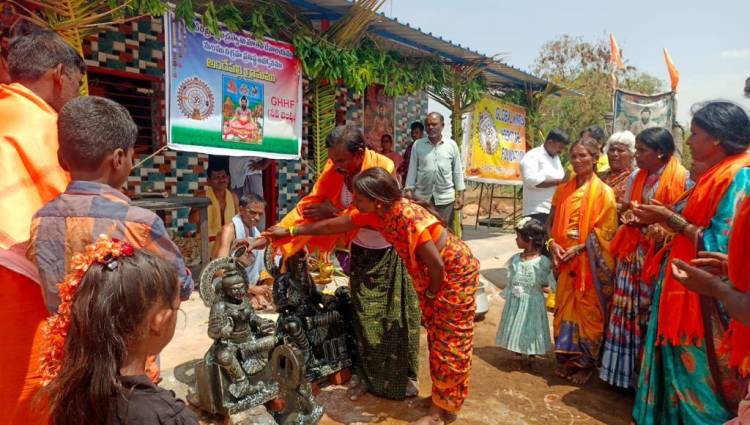[GHHF] Prana Prathishta was performed to Sri Pothuluru Veera Brahmendra Swamy in a New Temple in Andhra pradesh
 Swami Dayananda Saraswathi
Swami Dayananda Saraswathi
“conversion is an act of violence…aggressive religions have no God-given right to destroy ancient faiths and cultures… it is an act of violence because it hurts deeply, not only the other members of the family of the converted, but the entire community that comes to know of it. When the hurt becomes acute, it explodes into violence…humanity cannot afford to lose any more of its existing religious traditions.”
Global Hindu Heritage Foundation is very to inform you that our Chief Pracharak, Sri Gopikrshna Chary, and a well-known Priest in the area performed Prana Prathishta in Andepalli Village. He performed Pranaprathishta to Peddamma Talli deity.
Sri Gopi Chary has been visiting this village for more than a year and encouraging them to build Sri Veea Brahmendra Swamy Temple in Andepalli Village in Anantapur District. He performed Prana Prathishta to the Vigraha along woth Lord Ganesha and Gangamma Talli vigrahas in the Temple. In the beginning, he encouraged villagers to start Bhajan sessions and taught them to sing several bhajans mainly to develop bhakti in the deities. He promised the villagers to help install and make them participate in all the rituals irrespective of caste.
Praṇa Pratiṣṭhā refers to the ritual or ceremony by which murtis are consecrated in a Hindu temple. With the chanting of hymns and mantras, specially trained priests invite the deity to be permanent guests. After installing the Murthy, Prana (life) is infused into them. The murti's eye is opened for the first time. The ritual is considered to infuse life into the Hindu temple and bring to it the numinous presence of divinity and spirituality.
The ceremony marks the recognition of the image of god to represent "a particle of the divine whole, the divine perceived not in man's image as a separate entity but as a formless, indescribable omnipresent whole", with the divine presence a reminder of its transcendence and to be beheld in one's inner thoughts during darśana in the temple.
What is Prana Pratishtha?
‘Prana’ refers to life energy whereas ‘Pratishtha’ means position or resting. In this context, the word when combined means installation or consecration.
Ritual of Prana Pratishtha
Vaishayasi Samhita says one in whose every organ Paramatma resides wholly, that pure Mahapirusha is eligible to perform Prana Prathishta because one who can invoke Paramatma within his heart to the murti can offer it.
In the process, the murti is cleansed for touching them by artisans while chiseling the murti, , ksheeradivasa, jaladivasa, danyadivasa, and snaps were performed.
The ritual involves typically a puja, chanting mantra in Sanskrit, bathing, and cleaning the idols of Gods and Goddesses. The pandits (priests) in the temple wash the feet of the deity (like a revered guest) arriving after a long journey.
After Prana Prathishta, they dress up the idol and keep it seated in a comfortable place. They keep the idol facing the east direction.
Thereafter, the priests touch different parts of the idol which signifies the presence of various Gods as different sense organs like Indra as hand, Surya as eyes, and so on.
The main part of the ritual is the opening of the eyes of the divine with scented water and flowers. After this the consecration of the idol is complete.
The Use of Mantra:
Mantras are chanted during the homas and during the rituals especially when the installation is taking place. A mantra is an invocation, containing a sacred syllable or set of syllables. Mantra is uttered with specific rhythm, with sincerity of devotion, concentration and purity of thought and action, and with phonetic and grammatical accuracy. They are chanted in a manner prescribed by the scriptural injunctions of the vedas or some authoritative scripture. Different mantras are invoked depending on a particular deity and compel the deity and enabled to assist the invoker to achieve a desired end. The chanting creates the necessary vibrations in the atmosphere to awaken the deities and facilitates their descent to the place of worship. The sound that is generated by the chanting of the mantras is very important, but is not the only requirement for the yajna to be successful.
DONATIONS
PayPal Method: To donate visit our website: savetemples.org. Click on the Donate button, then press the Purpose category, and select the General Donation category.
By Check: Or you can send a check payable to GHHF, . It is tax-deductible.
By Zelle: ghhfusaorg@gmail.com
By Rupees, please contact us by either phone or email.
For more information, call in USA: Prakasarao V Velagapudi at 601-918-7111; in India: call Sreenivas at +91 83096 43979
Email: ghhfusaorg@gmail.com





















 Urgent support needed for Bangladesh Hindus
Urgent support needed for Bangladesh Hindus 







